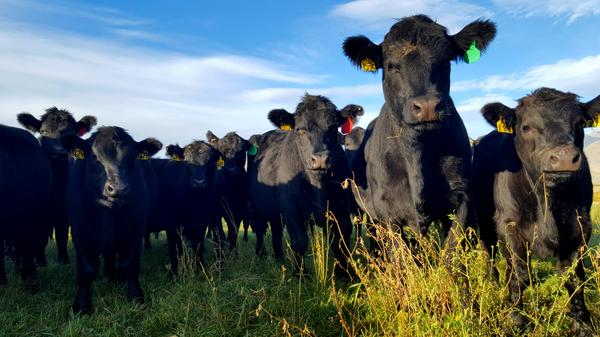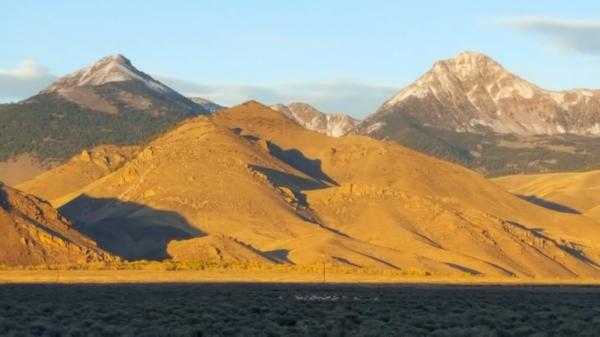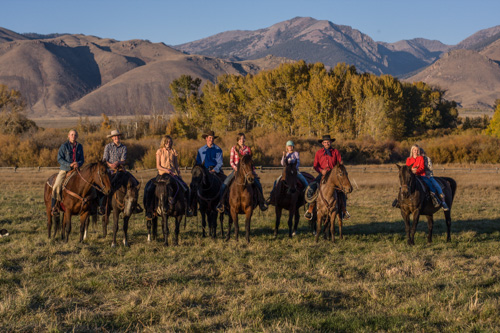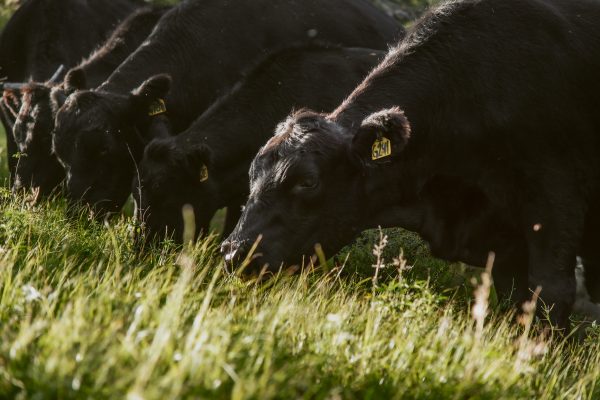Summer is officially gone, and winter steals its way into the high Pahsimeroi. The barren peaks were pounded with a foot of icy white last week, and autumn colors wend through the river bottoms. It’s lovely most days, with temps in the 60s, but nearly every night brings frost, making grasses a little more edible by breaking down some of the stems that in high summer were too tough to chew. Most of the grass is in a highly palatable leafy state right now, and packs some serious flavor. It’s still green, in spite of the frost, as nearly all of the 20 some species that the beeves graze on are classified as cool season grasses, those plants that thrive in the northern climates around the globe.
I’m grilling NY strips as I write this. They are testers. I just put a little flaked sea salt on them, and grill them lightly to medium rare. Most of you know that we test a NY strip from every beef we sell online, ensuring it meets the Alderspring standard of flavor and tenderness. These are a leaner bunch of steaks and I was concerned that we would lose flavor without the fat to carry it across the tongue. But so far, they have had great tenderness and flavor results.
This same phenomenon happens every year when we bring cattle back from the range; indeed, they are young, but the grass they live on up there in the wilderness yields what I believe to be some of the richest flavored beef on earth. Why? It’s because with that foundation of untouched soils in a wild setting, the nutrient density that raised wild ungulates for millennia is still intact.
Now we have the advantage of harvesting these native grasses with our beeves that we herd across this wild landscape. In comparison, nearly all other beef is raised on degenerated and dead soils that have a 100 year old history of crop extraction and replacement of wild soil nutrition with petroleum-based chemical fertilizers, herbicides and pesticides. They just don’t hold a candle to the flavor and health benefits of wild soils where the matrix of living organisms make mountain minerals available to the native plants that grow these soils. Then, our (ultimately your) beeves eat them. And thrive.

Caryl and I were on a date trip to Challis Hot Springs last night for a therapeutic swim to pull the kinks out of our muscles. It had been a long week, and a nice mineral soak at 106 degrees certainly beckoned. They have very large pools, and even if there are other folks in it, we find it a really nice time to talk family or business without distractions while relaxing.
Our half hour drive to the springs was almost behind us; a few more curves and low hills, and we would be there. The drive is all in the valley bottoms, and you pass through many ranches on the way. I was driving, so Caryl could observed the fields and meadows better than I could. Some hay was still being cut and baled; late for this time of year. Most operators had put their hay equipment to bed for the winter, and had turned their hay meadows over to the cows. Caryl noticed a spray rig, bumping down through the pastures, nozzles wide open, misting the pasture plants below them. “What could they be spraying at this time of year?”
“It’s got to be Roundup. They’re killing all of the grass and remaining alfalfa before they no-till-drill it to a new crop. It has to have enough vegetative mass above the ground for the Roundup to stick to it and get a good kill.” Roundup is Monsanto-created glyphosate. It is the most common herbicide used in agriculture today. It kills entirely through leaf contact. I looked over at Caryl. “They’ll probably put cows on there right after they spray. Most guys do. They figure there’s no sense in wasting all of that good feed. It’ll stay green for a few more days.”
“You’re kidding, right? I knew they used Roundup to kill pastures and alfalfa stands before reseeding, but seriously, they’re going to graze the spray ground?”
“It’s a pretty common practice. I know guys who label their cattle as “Natural Beef” who do it; and it’s totally permissible to employ the same protocol while being grass fed.” We were now rolling into the Challis Hot Springs. It looked like there were quite a few other folks wanting a soak on this lovely evening as well. The sun was going down over the mountains, and a rosy alpenglow covered the peaks. A crescent moon would illuminate the quiet waters tonight. We got out and walked toward the pool.
“That’s really gross.” Caryl turned and headed for the ladies’ changing room in the chill air of dusk.
That’s not a very scientific comment from my PhD wife, but she’s right. Unfortunately, it’s pretty common, even in grass fed beef production. It’s unthinkable for me to do that to our cows, because I think gut bacteria is the key to health. Glyphosate has been shown to impact gut bacteria, both in animals and in us. Cattle are ruminants, meaning their whole digestive system is an elegant symbiosis with a diverse gut microbiome. In many ways I think I am a microbe producer- I think about the microbes in my ranch’s soil and in my animal’s guts, the two intertwined by a diversity of grass.
************************************
We had our organic inspection last week (we passed with flying colors). Our inspector this year was Gwen, from the Idaho State Department of Agriculture’s Organic Program. She happily waded through record books, and walked meadows and through our entire herd of beeves. She looked at a random package of Alderspring ground beef, and by looking up the lot number, traced the entire life of that steer from birth to finish via our records. She did the same with individual live steers, tracing their existence in our herd records from birth to where they walked on our pasture that day. It was exhausting day, and quite a thorough check-out for both of us.

I showed her where we had hand-treated weed populations with our crews, and where we had released beneficial insects that eat weed species (a dollar a piece!). All told, our books showed that we spent over $24,000 in non-chemical weed treatment alone on the ranch. And that just scratched the surface of what we did to be organic that she questioned us about, all within the requirements of the National Organic Program (NOP), which included biodiversity enhancement of species we share the ranch with, soil biota assessments, pasture health, animal health, animal welfare, reduction of animal stress, and a host of other biological themes.
She carefully inspected the miles of buffer strips between us and conventional producers that border us in case they sprayed something like glyphosate. We ensured that our beeves couldn’t even get to a neighbor’s fence. Our 7 miles of fence in the valley that separated us from other operators had to have not one, but two fences on them to keep our cows off the “buffer strip,” a zone where chemical windborne drift could send spray over our fence from their equipment.
It was our 12th inspection. Our “T’s” were crossed, and our “I’s” were dotted. She gave a few good suggestions of what we could do to improve our operation and records and headed back on the long road to our State Capitol in Boise. I gave her my required $5200 fee for the organic program, and she promised to send me a bill for her inspection (usually around $1000).
You may wonder why I told you about this. I’m setting the stage for a little email message I received from a long time “charter” customer in California. It was Len. He occasionally asks some really penetrating questions about our practices and our products, and has offered good advice on several occasions, which we happily received.
He said that “a company [in California] which claims to offer pastured chickens, grass-fed beef and the like has been sending me emails. Among its “information” is this:”
“…At this time, Food and safety code and regulations PROHIBIT the open sale and public distribution of meat, poultry and eggs which are raised without…chemicals, YES even certified organic..”
Back to Len: “What are they talking about? It doesn’t sound like your practices.”
Well, we often see stuff like this from our non-organic competitors. The fact of the matter is that organic is NEVER required to use chemicals, but if animal welfare is at stake, and no organic treatment is possible, you are ethically required under organic rules to treat them non-organically, perhaps with antibiotics, to save their lives. These animals must be removed from the organic certification.
The organic rules are not only about chemical-free, but they also address humane treatment and stewardship. Indeed, we have 2 or 3 beeves like this every year. They may have pneumonia, or a chronic foot injury that abscesses, and we doctor them with life-saving antibiotics. We sell them outside of our webstore with full disclosure.
That said, I’ll return to the anti-organic spin Len shared with me. We’ve seen so much of this lately, and nearly all of it comes from producers who have researched organic and find that it is practically and economically impossible for them to produce their products to the standard organic requires.
It is a very high bar above even typical grass fed protocols. In fact, most “grass fed” producers are years and a multitude of clean protocols away from organic. I know, because “I was one once,” and have consulted for many grass fed growers seeking organic certification. Most of them sadly turned away. It has way more to it than simply saying goodbye to hormones and antibiotics.
Not only does it cost a lot to deal with weeds by hand and invest in soils by feeding them with organic matter (we “waste” 20% of our hay each season by overfeeding our beeves and letting the soil biota eat that extra we leave behind; it amounts to some $5-10K per year), but our impeccable records give complete traceability to where all of our animals lived for every second of their lives (they must always walk on organic soils to be certified).
What’s the bottom line? Why do we bother with organic? Because it’s about trust. It’s the least we can do to earn your trust. Even if you did visit a ranch, there is so much a producer can make sure a customer doesn’t see, and so maintain a look of uncertified organic. But in our experience, the inspectors know their stuff, and the inspections are real, tough, and can result in violations and in many cases, retraction of certification.
We see so many producers claim to be “essentially organic” or even “beyond organic.” My observation is that if these conventional grass fed producers were truly chemical free, the actual certification is a fairly simple next step. It was for us. So if they don’t embark on that simple step and certify, and instead diss organic, well, I start wondering why.

They may tell you they don’t like big government, and that’s why they don’t certify (I don’t either, and I think that excuse is lame). They’ll say that organic is run by big companies who cheat. Indeed, many big companies are players, but the fact of the matter is that they do get caught and rapidly lose market share when they do. Consumers stop trusting them. For example, Horizon organic milk lost millions in revenue and legal fees when they were found not to offer pasture to their dairy cows (now, they are back on track, and that pasture gate is open).
They may say it is expensive to be certified organic. It is. But it is not the actual cost of certification that is expensive, it is the practices that are required in order to be certified that are expensive. If they already are following all of the organic practices, adding the certification should not be a big cost.
Some of them know better. The big boys peddling their “grass fed” beef that is “beyond organic” know better. Some smaller producers are not deliberately deceptive, and truly think they are almost organic, but they haven’t really read all the requirements and lack understanding about the scope of being certified.
Case in point: Tom, a friend of mine and a good honest guy who runs cows in the next valley called me last week. “We’re gonna be certified organic next spring. We have an inspector coming out next week to check us out. Will you consider purchasing some of Angus grass fed weaner calves (just weaned from mom) when we do certify? Could we partner on a deal like that?”
“I’d sure consider it, Tom. I’d have to take a look at your genetics and see if indeed they’ll be the right type to match our wild ranges. A lot of conventional Angus fail up there and can’t forage well in that landscape. I’d also have to look at your whole operation from how you treat your beeves to your care for the land to make sure you are a fit to our vision. So you have the ground certified that those cows are living on right now?”
“Well, no. We have about 150 acres of hay we cut for them that’s been chemical free for 4 years.”
“Are the cows on it?” I paused for a second and waited. “And do you have clean stock water in a well or something that they can get a drink from when you winter them on there?” Long pause.
“Well, we can’t do that. We’ll wreck our alfalfa by wintering cows on it. And there’s no water there.” Sigh on the other end of line. “So the ground under them has to be certified?”
“Yep. Sure does.” I didn’t even want to broach the subject about his buffer strip program to prevent contamination from spray drift. And documentation that the drinking water for the animals was clean and not coming from a ditch that ran through a neighbor’s field. And their fly tags with organophosphate. And the pour-on insecticides used ubiquitously by nearly every cattleman I know to kill internal parasites (let that sink in- no pun intended: the insecticide is poured on the back of the animal and kills parasites on the inside of the animal). I knew from experience that many aspiring organic producers have not even thought about these things. He would be a quick study but he was a long way from organic certification.
“Dang. It could be another year. We’ve been trying to work toward organic for 3 years. I had no idea.” Tom didn’t connect with the fact that his wintering beeves could eat a little crop residue anywhere they were. It’s why we have to drop certification of animals that break through the fence and get on to the neighbors, even if our neighbors never used chemicals.
“The rules aren’t that complicated. No chemicals…at all…on land or beast, while providing the best husbandry and stewardship for your land and animals as you can. That about sums it up.”
Organic is the only test for clean and pure out there. It’s not perfect, but it’s pretty good. Everything else is smoke and mirrors. Caryl and I browse many websites in our biz and often find that tricky wordsmithing and what they do not say is meant to manipulate customers into believing they are “better” than organic. It’s lying by omission, taking advantage of a customer’s ignorance.
For example, they’ll say they “never feed hormones” but neglect to explain that hormones aren’t just fed, they are more typically administered through an injected slow release pellet placed in the ear, which they implanted in every one of their beeves just last week. But technically, they never fed hormones.
These are hard to resist: a $1 pellet typically results in $7 extra weight, a substantial return in razor thin commodity beef production. But with some careful wordsmithing, the consumer still thinks they are getting beef free of added hormones. I don’t decry or demonize the production protocol (although I don’t like it); what makes me mad is the deception.
More and more I’ve seen abuse of the term “grass fed;” a completely unregulated but trendy and financially-rewarding adjective to add to your beef. The beef could be eating grain in a feedlot, and the consumer may never know, all the while thinking they are feeding their family wholesomely raised grass fed beef from our dear Farmer Brown down the road, and paying substantially more for it.
I have a friend in the grass fed industry who sent away a “grass fed” burger sample to be lab tested for its Omega 6 to Omega 3 ratio. Most feedlots who feed grain test between 15:1 to around 18:1. Most grass fed beef is in the single digits: 5:1 or so. Some grass fed producers even come in at 1:1. In general, the lower the Omega-6 component, the more it is indicative of natural green pasture origins and the accompanying wellness increase from consuming it (it’s why salmon is so good for you- it has more Omega 3s).
This producer is one of the largest grass fed purveyors in the western US. The Omega-6 to Omega-3 ratio came in at nearly 150% higher than the corn fed. Yep, the “grass fed” beef had a fatty acid profile that blew feedlot beef out of the water”¦and not in a good way. When I asked about the crazy high O-6 dominated ratio, my friend simply said “They’re liars, Glenn.”
They were cheating, creep feeding some grain feedstuffs on the sly. Who’s going to know? But a lot of people are paying more money for beef that doesn’t give them the health benefits they are looking for in grass fed and organic.
So we believe we owe passing the test of certification to you, our partners. I think it’s too much to ask you for a blind trust, at least initially when you first become our partner. Third party verification of our practices makes us both rest easy that the food we offer you and your family is clean and chemical free, humanely raised, and also cares for the wild plants and animals we share our ecosystem with (those are all covered in the exhaustive certification of organic).
I think on Alderspring we truly are “beyond organic.” I don’t know of any other grass fed organic producer that has been doing this for over 20 years as we have. The passion we feel at our core about the rightness of this, both for our land and for the health of the people we serve, carries us through disappointments and hard times. As we learn more, we get even better at caring for this piece of earth and the animals that grow here, becoming more and more in sync with natural systems and seasons. And, I hope, we are getting better at serving you.
Thanks for being part of this “above the bar” organic operation. Happy trails!
Glenn, Caryl and girls.








Leo G Younger
Regarding your comment about “Horizon organic milk” being back on track, leaving the gate open for now, I’ve just checked at organicconsumers.org where they have a search field (with the magnifier glass symbol) near the upper right corner. You all can do this, and please do. I copied Glenn’s article’s phrase, Horizon organic milk, and hit enter. In the resulting pop-up, there’s a choice of relevant or date in the upper right of that pop-up. Choose date. 300 results appeared, starting with the most recent. Horizon has a documented history. This search was on January 23, 2020. You can subscribe, free, to organicconsumers.org. I donated thousands to them, but it’s not mandatory. You can use their website which is very helpful.